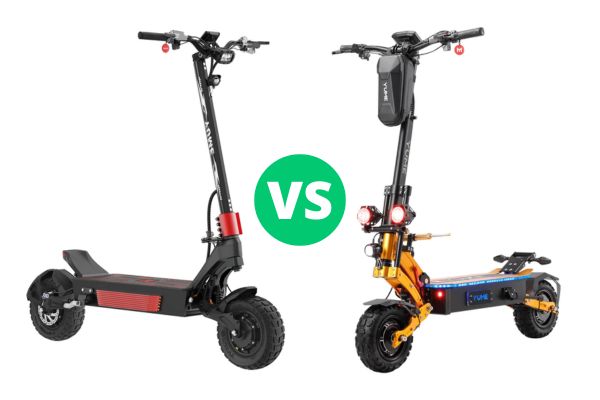In the expanding universe of high-performance electric scooters, YUME has emerged as a brand that doesn’t just follow trends, it sets them. Among its growing range of models, two stand out for very different reasons: the YUME Predator and the YUME X11+. These scooters are not competitors in the traditional sense; rather, they are representations of two parallel strategies aimed at two distinct types of riders.
The Predator is YUME’s bold, no-compromise statement. It’s the engineering flagship, the “halo product” that shows what the company is capable of when pushing every technical limit. It features components usually reserved for electric vehicles, including a 72V battery system with automotive-grade pouch cells, liquid-cooled motor controllers, and a structural mass that gives it an imposing presence.
In contrast, the X11+ is a calculated masterpiece of value. It delivers thrilling top speeds, rugged terrain handling, and rock-solid dependability while remaining relatively affordable. It avoids overly complex systems in favor of refined, proven components. This makes it a favorite among riders who want 90% of the high-end performance at half the price.
So how do these two titans compare when you break them down to the nuts and bolts? This article explores every layer of design, performance, and usability to help you make the right decision.
YUME Predator vs X11+ Plus: Comparative Technical Specifications
| Metric | YUME Predator | YUME X11+ |
| Price | $3,599–$4,399 | $1,490–$1,799 |
| Top Speed | 63 mph | 50 mph |
| Range | 100 miles | 56–60 miles |
| Motor Power | 2×4000W (8000W total) | 2×3000W |
| Peak Power | ~10,080W | ~6000W |
| Battery Voltage | 72V | 60V |
| Battery Capacity | 50Ah | 27Ah / 30Ah |
| Battery Type | Panasonic EV Pouch Cells | Standard / Samsung 21700 Cells |
| Battery Life | ~2000 cycles | ~500 cycles |
| Controllers | Water-Cooled Custom Controllers | Dual 45A Sine Wave Controllers |
| Weight | 170 lbs | 98–110 lbs |
| Max Load | 330 lbs | 330 lbs |
| Brakes | Quad-Piston Hydraulics | ZOOM Dual-Piston + eABS |
| Tires | 13” x 4.73” Tubeless | 11” x 3.95” Tubeless |
| Suspension | Triple Adjustable Hydraulic | Front Hydraulic + Rear Spring |
| IP Rating | IP54 | IP54 |
| Key Features | Removable Battery, Water Cooling | Steering Damper, Dual Throttle |
The Predator’s Future-Focused 72V Powertrain
The Predator’s powertrain is where it truly sets itself apart. Unlike most scooters that use a bank of small 21700 cylindrical cells, the Predator opts for 20 large Panasonic EV pouch cells. These are the same cells found in modern electric vehicles, offering lower internal resistance, more stability, and significantly longer lifespans. With 72 volts of system power and a 50Ah capacity, the scooter delivers a whopping 3600 watt-hours.
This not only results in jaw-dropping range (up to 100 miles in ideal conditions) but also in exceptional energy efficiency and fewer internal heat issues. YUME then paired this advanced battery with water-cooled controllers, an industry first for consumer scooters. These custom 45A sine wave controllers are housed within a liquid cooling system that actively pulls heat away from the unit, allowing the motors to run at peak power for longer durations without overheating or performance throttling.
The Predator isn’t just fast, it’s consistent. Unlike many scooters that begin to lose power during extended rides or while climbing steep hills, the Predator maintains its output. This means that your real-world performance stays as strong at mile 30 as it was at mile 3.
And with 2000 recharge cycles, the battery could potentially last over five years, even with frequent daily use. This long-term reliability alone begins to make its premium price more understandable; it’s not just a scooter, it’s an investment.
The X11’s Proven and Balanced 60V System
By contrast, the X11+ plays a more traditional but equally smart game. It uses a 60V battery system paired with dual 3000W motors. While that may seem conservative compared to the Predator, this combination is time-tested and delivers excellent results.
The scooter can hit a top speed of 50 mph, and acceleration is sharp and satisfying. With either a 27Ah or 30Ah battery (the latter made with Samsung 21700 cells), the X11+ offers up to 60 miles of range under optimal conditions.
One of its key strengths is the dual sine wave 45A controllers. These ensure buttery-smooth throttle control, avoid the harsh jerks found in older scooters, and make riding the X11+ feel intuitive and responsive. It’s this careful tuning that turns standard components into a refined powertrain.
For most riders, the X11+ will feel more than powerful enough. Its 6000W peak output is impressive by any standard, especially when paired with a scooter that weighs significantly less than the Predator. It’s about finding the sweet spot between performance, cost, and ease of ownership.
Verdict: Performance vs Practicality
If your goal is owning the most powerful, longest-lasting, and most technologically advanced scooter available, the Predator is the clear winner. But if you want excellent performance without complexity or financial strain, the X11+ gives you incredible bang for your buck.
The Predator’s High-Speed Cruiser Feel
At 170 lbs, the Predator is one of the heaviest scooters on the market, and that’s intentional. The weight provides high-speed stability that lighter scooters simply can’t match. Combined with 13-inch wide tires and a wide, low deck, the scooter stays grounded at high speeds and delivers a confident, planted feel.
Its triple-hydraulic suspension setup includes a 2000lb-rated shock in the front and two 1200lb shocks in the rear. These aren’t just for show; they soak up potholes, curbs, and trail debris with ease, allowing you to cruise over rough terrain without discomfort or instability.
This makes the Predator perfect for riders who want to travel long distances at high speeds. You don’t just ride the Predator, you glide.
The X11’s Agile, Trail-Ready Design
On the flip side, the X11+ is all about agility. At around 100 lbs, it’s more than 70 pounds lighter than the Predator. It’s nimble, fast to respond, and can change direction quickly. Whether you’re weaving through city streets or carving up trails, it feels lively and playful.
It uses a spring-hydraulic suspension system and rides on slightly smaller 11-inch tubeless tires. These provide a nice balance of shock absorption and responsiveness. It also features a built-in steering damper, an addition rarely found on scooters at this price point. This damper helps prevent speed wobbles and keeps the ride steady when pushing the top speed.
Verdict: Cruiser vs Trail Fighter
Think of the Predator as the SUV of scooters, big, stable, and luxurious. The X11+ is the sports sedan, nimble, agile, and exciting. If you want to blast down a straight road in complete comfort, choose the Predator. If you love quick maneuvers, tighter turns, and dynamic control, the X11+ is your ride.
Braking Systems: Custom vs Trusted
The Predator’s quad-piston braking system is custom-designed to match its extreme performance. The added pistons increase stopping power and reduce the risk of brake fade. These brakes are essential for a scooter capable of hitting 63 mph.
In contrast, the X11+ uses trusted ZOOM dual-piston hydraulic brakes combined with electronic ABS. These brakes are standard among high-performance scooters and have a solid reputation for dependability. While not as overbuilt as the Predator’s setup, they are perfectly suited for the X11’s lighter frame and speed range.
Portability: Removable vs Manageable
The Predator has a removable battery, which is a huge benefit. You can charge it indoors or swap it for a fresh pack, extending your range indefinitely. However, the scooter’s sheer size means it isn’t portable by any stretch. You’ll need ground-level storage and probably won’t be lifting it into any car trunks.
The X11+ doesn’t have a removable battery, but it is significantly easier to move. With some effort, it can be lifted into a vehicle or carried up stairs. For those living in apartments or needing transport flexibility, this makes a big difference.
IP Ratings: A Shared Weakness
Both scooters have an IP54 rating. That means they are protected against dust and light water splashes, but not against heavy rain or puddles. For vehicles advertised as all-terrain, this is a letdown. Riders will need to be cautious during wet conditions, as water damage is not covered under most warranties.
Conclusion: Choosing Your YUME
The Predator Rider – The Tech-Obsessed Maximalist
This is the rider who wants the best of everything. They are not afraid to spend more for top-tier features, extended battery life, and game-changing technologies like water-cooled controllers. They probably have a garage or private storage area and don’t mind the scooter’s weight. They are focused on long-term ownership, maximum performance, and cutting-edge innovation.
To them, the Predator is not just a scooter; it’s an engineering marvel that satisfies the craving for speed, comfort, and advanced features all in one package.
The X11+ Rider – The Real-World Enthusiast
This rider wants serious speed, a strong range, and good quality, all without breaking the bank. They value practicality, and the X11+ gives them exactly that. It offers smooth power, excellent agility, and a high fun factor. It’s easier to store, easier to move, and easier to afford.
This makes it perfect for city riders, weekend explorers, or anyone who wants powerful performance without the size or price of a flagship scooter.
Final Thoughts – YUME’s Two-Path Strategy
YUME has done something clever with these two scooters. The Predator isn’t just a product; it’s a statement. It says that YUME is ready to compete at the top of the market. The X11+ proves that the brand still remembers its roots, affordable, powerful, and accessible machines built for everyday riders.
Choosing between them comes down to what matters most to you: innovation or value, cutting-edge performance or reliable thrill, the future or the refined present.
Either way, you’re not just buying a scooter, you’re investing in a vision of what high-performance PEVs can be.




